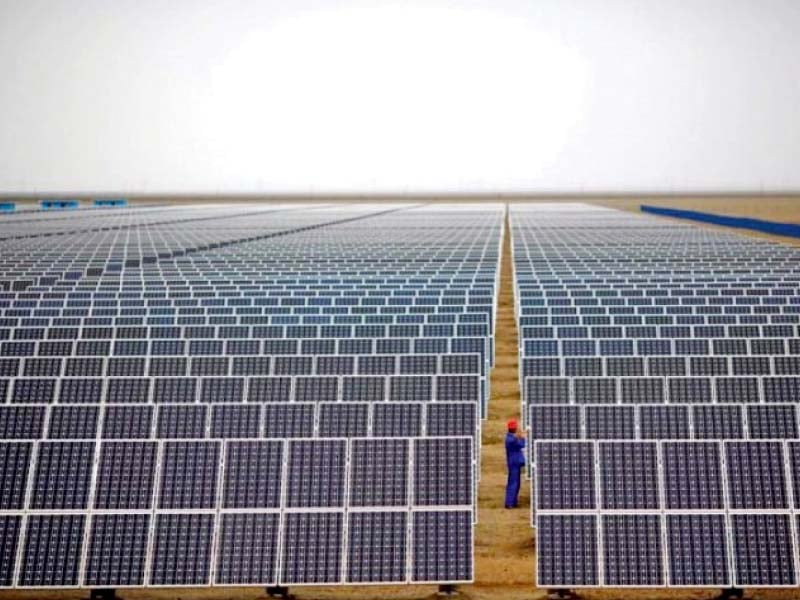
Pakistan is feared to lose billions of dollars of investments in solar power projects in the face of a government plan to bring down the tariff on this renewable energy source.
Prospective foreign investors, who have planned to establish solar energy projects in the country, are increasingly worried over the proposed reduction in tariff - the high rate of which is a major incentive for them.
They are also uncertain whether their projects would see the light of day after the tariff cut, though they have invested millions of dollars in feasibility studies and acquiring the Letter of Intent from the government.
Read: Development Projects costing Rs4b approved for Bahawalpur division
To arrive at a decision on the revision in tariff, the National Electric Power Regulatory Authority (Nepra) will conduct a public hearing on Wednesday (today). Foreign investors have also been invited to participate in the hearing and give their vital input.
At present, the tariff on solar energy projects stands at 14.15 cents per kilowatt hour and there are plans to push it down to 9.25 cents per unit.
The foreign investors raised questions over implementation of the current tariff plan and its proposed revision during a seminar titled “Solar energy trade mission” here on Tuesday.
Julia Ju, who represented Zhenfa Energy Group Co of China, told The Express Tribune that they wanted to establish solar power plants of 300 megawatts in three phases in Pakistan.
“In the first phase, the company is planning to install a 100MW plant, but it will not be feasible after the reduction in tariff,” she said, adding Zhenfa had already installed such solar plants in China, which had the capacity to produce 1,300MW.
“The project in Pakistan is the first effort by the company outside of China,” she said.
Read: Pakistani researchers develop solar-powered mobile phone network
Reon Energy Solutions Business Development Manager Jahanzeb Khaliq Toor told the audience that the planned tariff cut would slow down investment flow into solar energy in Pakistan.
He argued that it was not fair to link the tariff with the price in neighbouring countries where financing costs and other issues were different when compared with Pakistan.
Nepra’s Member Tariff Khawaja Muhammad Naeem announced that the proposed tariff of 9.25 cents would be applicable from January next year. The new tariff was being determined in line with the electricity tariffs in comparison to other alternative energy sources, he said.
Naeem told investors that they could receive the current tariff if they had the Letter of Intent following the completion of documents.
At present, the tariff on hydroelectric power generation stands at 1.74 cents per unit, nuclear power 6.50 cents per unit, gas-fired electricity 7.47 cents, coal power 10.72 cents, bagasse-based electricity 11.98 cents, wind power 12.90 cents and furnace oil-based electricity 12.52 cents.
The initial tariff on a solar energy project was 17.36 cents per unit whereas the levellised tariff - average tariff spread over the lifetime of the project - was 14.15 cents, Naeem said.
Alternative Energy Development Board Chief Executive Officer Amjad Ali Awan highlighted that they were pursuing solar power projects of 3,000MW capacity.
He said the government wanted to slash the oil import bill that totalled $10.45 billion last year, adding the share of renewable energy in the energy basket currently stood at 5% and it would be enhanced to 25%.
Read: In Nathiagali, solar water heaters help move away from wood
World Bank Lead Energy Specialist Richard Spencer, while speaking on the occasion, pointed out that electricity shortage in Pakistan was calculated at 7,000MW during peak hours, leading to blackouts of up to 15 hours a day.
He said 30% of revenues of power companies were caught up in the circular debt with average losses at 19% and recoveries at 89%. “(As a result) GDP of the country has been impeded by 2%.”
Published in The Express Tribune, October 14th, 2015.
Like Business on Facebook, follow @TribuneBiz on Twitter to stay informed and join in the conversation.

















COMMENTS (7)
Comments are moderated and generally will be posted if they are on-topic and not abusive.
For more information, please see our Comments FAQ